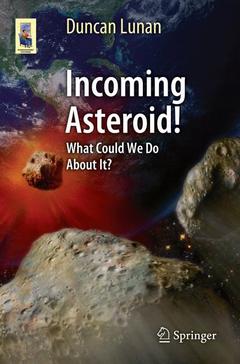Incoming Asteroid!, 2014 What Could We Do About It? Astronomers' Universe Series
Auteur : Lunan Duncan

?Incoming Asteroid!? is based on a project within ASTRA (the Association in Scotland to Research into Astronautics) to provide scientific answers to the question ? what would we do if we knew there was going to be an asteroid impact in ten years? time or less?
Clearly there are many things humanity can do nothing about, for example an unseen object traveling towards us so fast that we have no time to prepare, or an object so large it may be unstoppable. A realistic hazard model was decided upon, and the scenario developed from that: an incoming object about 1 kilometer in diameter, in an orbit ranging from the outer rim of the Asteroid Belt to within that of Earth?s.
Three basic possibilities are considered in this book. The first is the deflection of the asteroid, using remote probes along with a number of possible technologies to change the asteroid?s course. Second is the attempt of a manned mission, in order to plant a propulsion system on the asteroid to push it into a different orbit. Third is the nuclear option, a last-ditch attempt to break up and then disperse the asteroid using nuclear weapons. (A rather impractical combination of these second and third options were used as the plot of the popular 1998 Bruce Willis feature film, Armageddon.)
Although the cost of developing the technology needed to protect the Earth would be substantial, there would certainly be spin-off benefits. These could eventually result in practical small-scale atomic energy sources, new propulsion systems that could make extraterrestrial mining within the solar system a possibility, and other as-yet unforeseen benefits.
And finally, Incoming Asteroid! considers the political implications - how governments across the world should best react to the threat with a view to minimizing loss of life, and in the weeks running up to the possible impact, preventing panic in the population.
Duncan Lunan is a graduate of Glasgow University in Scotland, an M.A. with Honors in English and Philosophy plus Physics, Astronomy and French, and has a postgraduate Diploma in Education. A full-time author and speaker with emphasis on astronomy, spaceflight and science fiction, his books to date are “Man and the Stars”, “New Worlds for Old”, “Man and the Planets”, “Starfield” (edited), “With Time Comes Concord” and “Children from the Sky”. “The Stones and the Stars, Building Scotland’s Newest Megalith” was published by Springer in November 2012. He has contributed to 24 other books and published over 930 articles and 33 short stories. As Manager of the Glasgow Parks Dept. Astronomy Project, 1978-79, he designed and built the first astronomically aligned stone circle in Britain for over 3000 years, described in “The Stones and the Stars”.
Lunan was a Curator of Airdrie Public Observatory for 18 years, and in 2006-2009 he ran an educational outreach project from the Observatory to schools, funded by the National Lottery. His other interests include ancient and mediaeval history, jazz, folk music and hillwalking. After 30 years in Glasgow he recently returned to his home town of Troon, Ayrshire, where he lives with his wife Linda.
Date de parution : 10-2013
Ouvrage de 390 p.
15.5x23.5 cm



